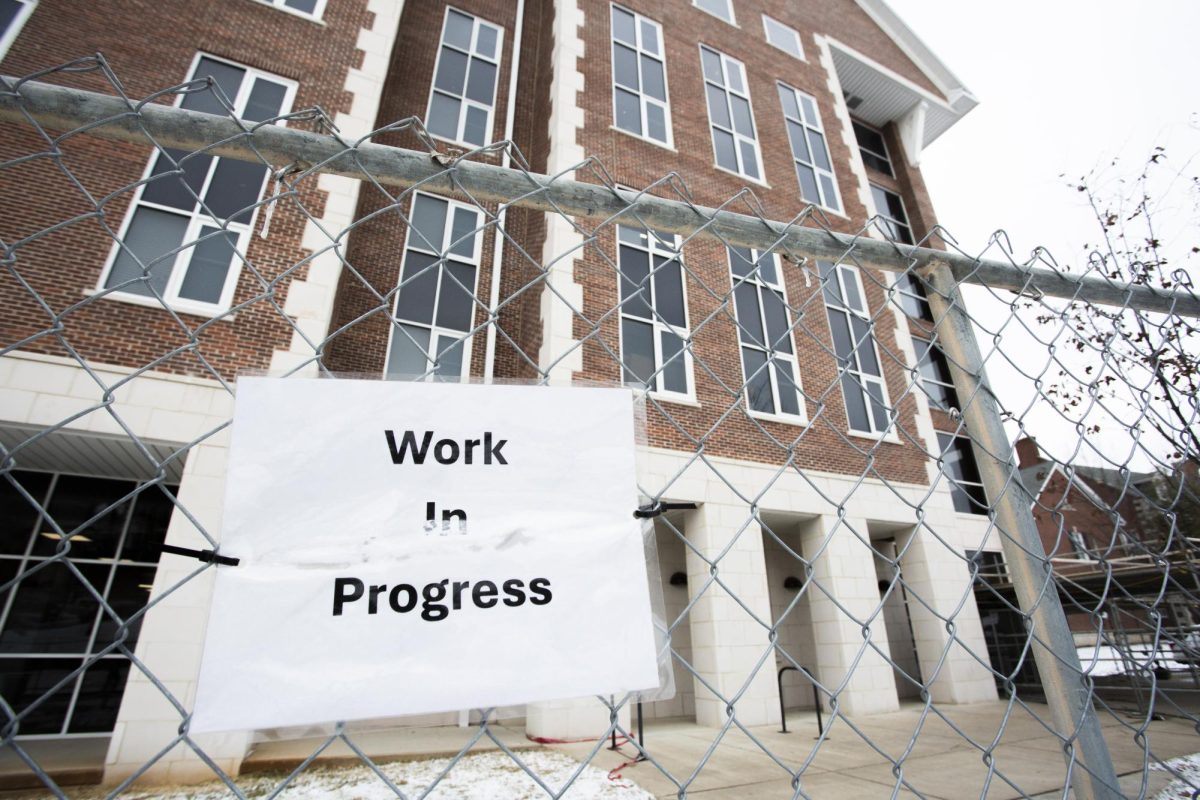Admission requirement change could impact student demographics
March 20, 2018
In an effort to reduce WKU’s budget deficit, the Budget Council released a list of suggestions for potential changes, one of which was potentially raising the Composite Admission Index score cutoff to 65 or higher instead of the current CAI threshold of 60.
The Budget Council also suggested terminating the admission of students with a CAI of 59 or below to “enhance retention and persistence,” according to the plan. President Timothy Caboni approved this suggestion but said he would evaluate the other suggestion to raise the cutoff to 65.
The CAI score is a way for applicants who do not meet the required ACT or SAT score or high school GPA to still be admitted to WKU. CAI is calculated by multiplying the unweighted high school GPA by 20 and adding the ACT score, according to WKU’s website. SAT scores are converted to the equivalent ACT score.
Under the current policy, applicants with a CAI of 65 or greater are guaranteed admission to WKU, according to the website. Applicants with a CAI between 60 and 64 are considered on a competitive basis.
Jace Lux, director of recruitment and admissions, said the CAI minimum was 55, so students with a CAI below 60 have been admitted. He said the CAI minimum was raised to 60 in fall 2017 for those in the incoming fall 2018 class.
Caboni has approved the CAI change that will prevent applicants with a CAI less than 60 from being admitted. If the other suggested change is approved, applicants with a CAI between 60 and 64 would no longer be admitted to WKU.
During a press conference following the presentation of the Budget Council’s proposals at the Board of Regents meeting in February, President Timothy Caboni took time to address the potential changes and the reasoning behind increasing admission requirements.
“Anytime we admit a student, we need to make sure that student has a reasonable chance of being successful,” Caboni said. “I think that has not been our past practice.”
Retention rate
According to data provided by the Office of Admissions, of the fall 2017 first-time freshmen admitted to WKU, 179 of them were admitted with a CAI below 60, and 255 were admitted with a CAI between 60 and 65. They made up roughly 4.6 percent of admitted students.
Only 70 of the students admitted with a CAI below 60 and 87 of the students admitted with a CAI between 60 and 64 enrolled at WKU, making up 5 percent of the total enrolled students.
Lux said it is typical for a university to admit considerably more students than it enrolls. In fall 2017, WKU admitted 9,352 students, but only 3,064 enrolled.
Caboni has said multiple times that it is not fair to admit students to the university who are unable to succeed and leave with loans once they leave WKU.
Over half of the students with a CAI of 60 to 64 who did not return the following fall left with loans. Of the fall 2016 students who were admitted with a CAI of 60 to 64 and left before fall 2017, about 73 percent left with loans, and the average cost of those loans was $4,837.
“If there’s a cohort of students we’ve admitted that have, essentially, a zero percent chance of graduating in six years, the question is, ‘Should we admit them?’” Caboni said. “I’ve said no. It’s not fair to them. It’s not fair to their families. It’s not fair to the folks that subsidize that education.”
The overall six-year graduation rate for students with a CAI below 65 was just under 15.5 percent for the fall 2011 cohort. About 6.4 percent of that 15.5 percent were students admitted with a CAI below 60.
The one-year retention rate of those students admitted with a CAI between 60 and 64 has consistently declined since fall 2014, when 42.3 percent of those students returned the following fall. In fall 2015, 39.6 of those students returned the following fall, and in fall 2016, 33.3 of those students returned.
In contrast, the one-year retention rates of those students admitted with a CAI below 60 consistently increased in those same years. In fall 2014, 18.8 percent of those students returned next fall; in fall 2015, 24.6 percent returned next fall, and in fall 2016, 26.2 percent returned the following fall.
Student demographics
Caboni said despite the changes, WKU will continue to focus on maintaining diversity at the university.
“I also am concerned and we will focus on ensuring that we remain a diverse institution,” he said during the press conference.
A majority of the 2017 first-time freshmen who were admitted with a CAI between 60 and 64 were African American, with 113 applicants admitted, followed by white, with 106 applicants admitted, according to the data from the Office of Admissions. Of the applicants with a CAI less than 60, a majority were African American, with 93 applicants, followed by white, with 67 applicants.
The total number of students admitted with a CAI between 60 and 64 was 255, but only 87 of those students proceeded to enroll at WKU. Of those 87, 60 percent were African American and 30 percent were white, with the other 10 percent identifying as Hispanic, Asian, Native Hawaiian or Pacific Islander and two or more races, with one non-reported student.
Of the 70 students who enrolled with a CAI less than 60, 54 percent were African American and 33 percent were white. The other 13 percent identified as Hispanic and two or more races, with one non-reported.
The demographic of students hit the hardest by the change in CAI requirements would be first-generation college students. In fall 2017, 99 first-generation students with a CAI below 60 were admitted as first-time freshmen. That same fall, 138 first-generation students with a CAI between 60 and 64 were admitted. The first-generation students with a CAI below 65 made up less than 7 percent of the total number of first-generation students admitted that fall and 2.5 percent of the total number of students admitted.
Lynne Holland, chief diversity officer, said in an email she is not worried about the changes affecting WKU’s diversity.
Other state universities
WKU is not the only Kentucky university to admit students who do not meet the standard admission criteria.
Like WKU, Morehead State University has a formula it uses to admit students, according to the university’s website. Unlike WKU, Morehead’s admission index is used for all students, but it has parameters for students who do not meet the standard requirements.
Morehead’s admission index, like WKU’s CAI, uses an applicant’s high school GPA and ACT score. The GPA is multiplied by 100; the ACT score is multiplied by 10, and the two numbers are combined. Applicants with an admission index score of 500 are admitted unconditionally in the same way WKU unconditionally admits applicants with a CAI of 65 of above.
Applicants with an index between 475 to 499 and 450 to 474 are admitted provisionally or conditionally, respectively, and must participate in student success programming.
Other schools take a holistic approach to admissions and don’t set GPA or test score requirements. The University of Kentucky, for example, looks at an applicant’s test scores and GPA while considering other factors such as completion of pre-college curriculum, according to the university’s website.
Lux said WKU implemented the CAI in fall 2012. He said he wasn’t working in admissions at the time, so he could not provide specific information about the decision-making process that led to the CAI.
“I do know that it’s a valuable tool to provide access to a WKU degree for students who may not meet either of the GPA or ACT admission requirements,” Lux said in an email. “My guess is that it was established to ensure that more people were able to access the opportunities WKU provides.”
When compared to the other state universities, WKU’s admission standards are similar with a GPA requirement and ACT or SAT requirement. WKU requires applicants have either an ACT score of 20, a GPA of 2.5 or a CAI score above 60. Lux said most of the applicants admitted to WKU are admitted based on their ACT or GPA. The CAI is only used for students who do not meet those requirements.
Of the 9,352 students admitted in fall 2017, about 93 percent of them were admitted based on ACT or GPA, according to data from the Office of Admissions.
Raising the threshold
Although the number of students enrolled with a CAI below 65 is relatively small compared to WKU’s overall enrollment, terminating admission for applicants with a CAI below 60 and possibly applicants with a CAI between 60 and 64 would slightly reduce the number of minority students at WKU and the number of first-generation students. Of the fall 2017 first-time freshmen enrolled with a CAI below 65, about 69 percent, were minority students.
A majority of the students at WKU are white, and they have consistently made up at least 75 percent of the student body in the past five years. That percentage of white students at WKU has remained relatively stable in the years between fall 2012 and fall 2016 with a less than 2 percent change, according to the WKU Factbook.
In those five years, the numbers of African American students, white students and American Indian or Native Alaskan students have decreased, with white students seeing the largest drop followed by African American students. At the same time, the numbers of Hispanic students, Asian students, Hawaiian or Pacific Islander students, non-resident alien students and students who identify as two or more races have increased.
When discussing WKU’s diversity and the CAI requirement changes, Caboni questioned whether enrolling minority students or first-generation college students but failing to retain them counted as diversity.
“If we have students who are first-generation college students that we admit in the fall semester because we want more of them, but they’re not here in the second semester, have we really increased our diversity?” Caboni said. “And so, we want to make sure that as we admit students that we’re paying very close attention to are they ready to be at a four-year university, are they prepared and can we get them to graduation? That’s the most important work that we’re doing.”
While Caboni has yet to make a decision on the potential admission requirement changes, Bob Skipper, director of media relations, said the information provided by the Office of Admissions and used in this article will be similar to what Caboni will use to evaluate the Budget Council’s suggestions.
An earlier version of this story incorrectly stated Morehead State University’s admissions formula. The high school GPA is multiplied by 100. The Herald regrets the error.
News reporter Emma Collins can be reached at 270-745-6011 and emma.collins399@topper.wku.edu. Follow Emma on Twitter at @_mccain_emma_.















